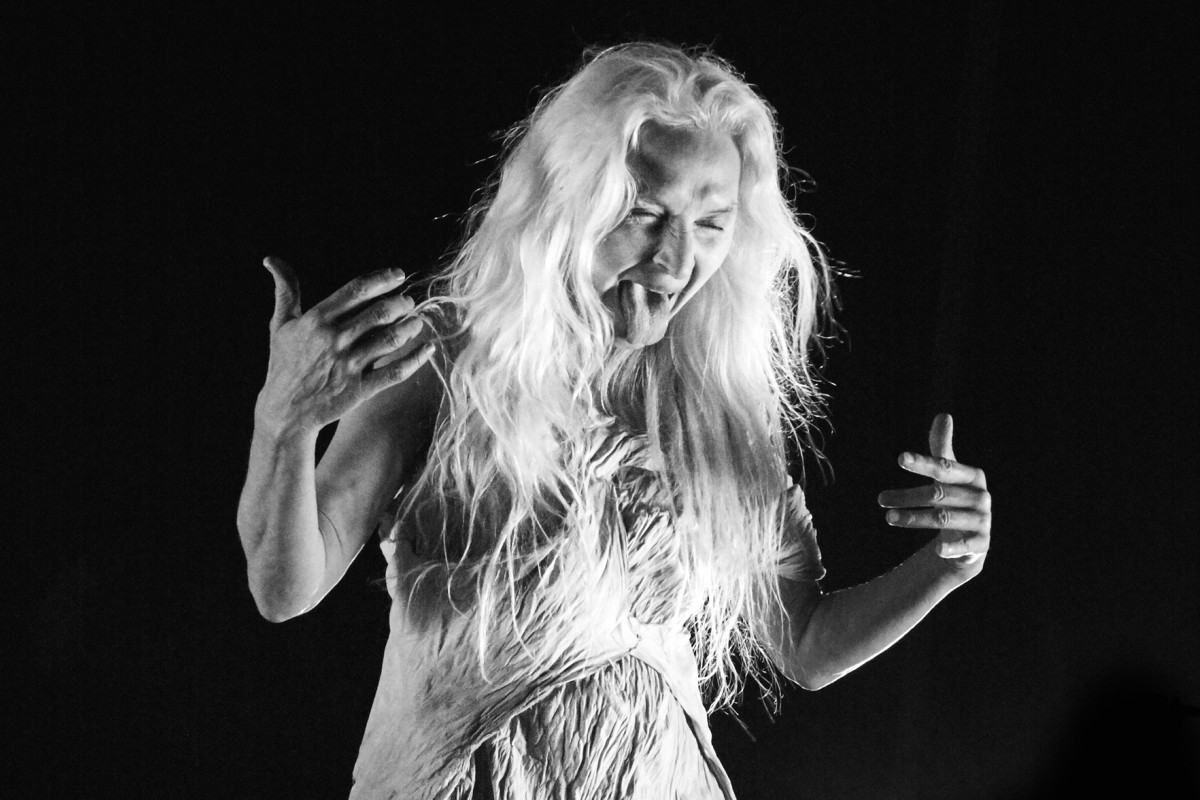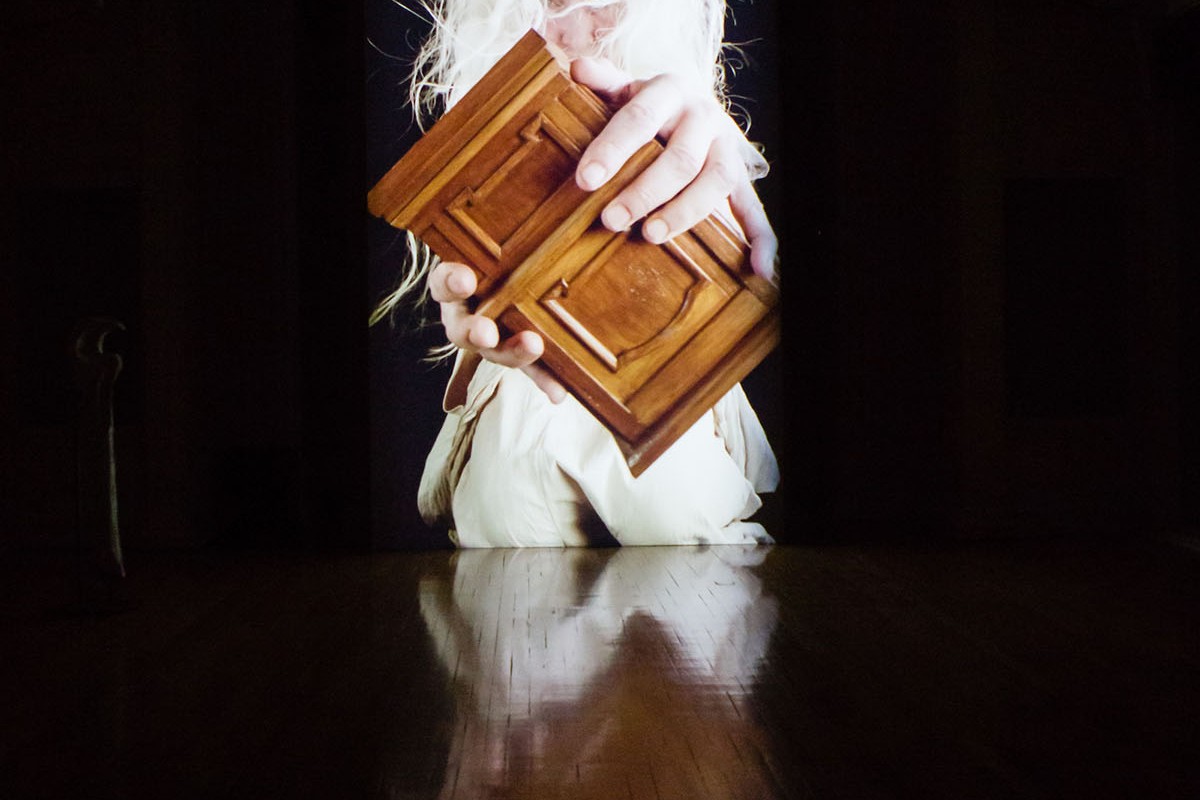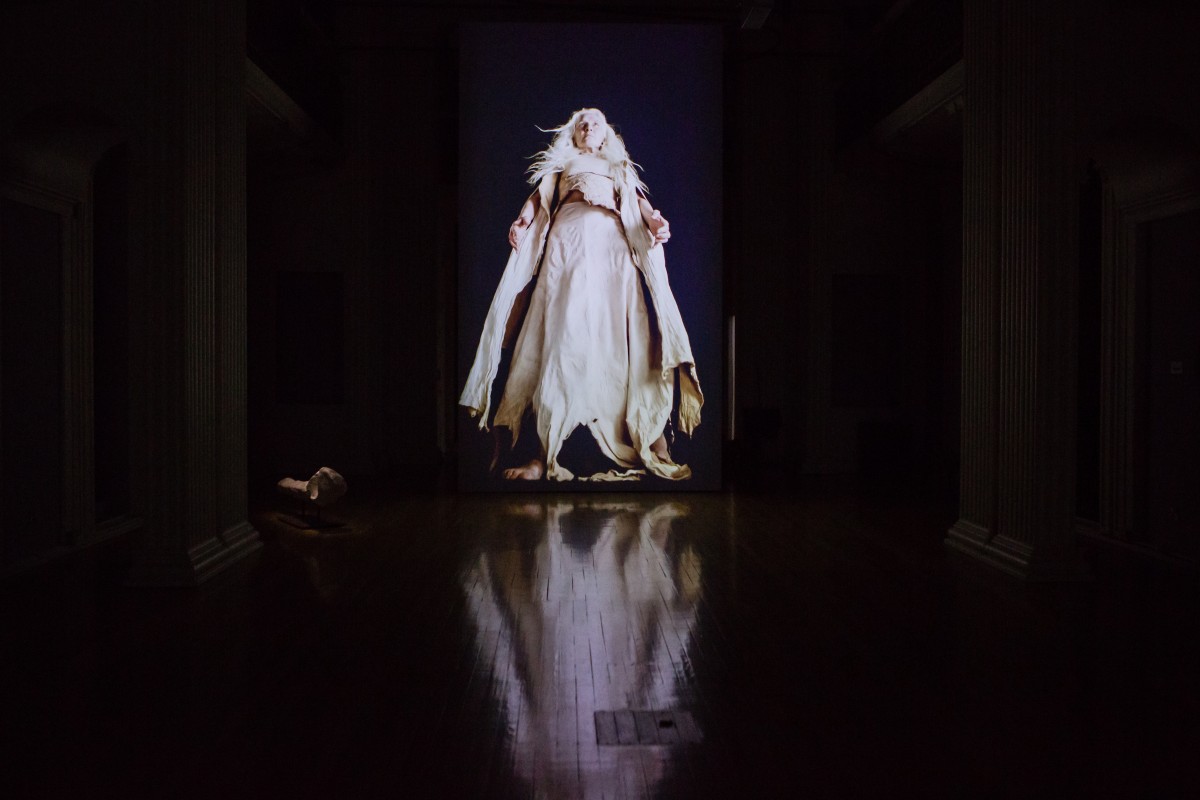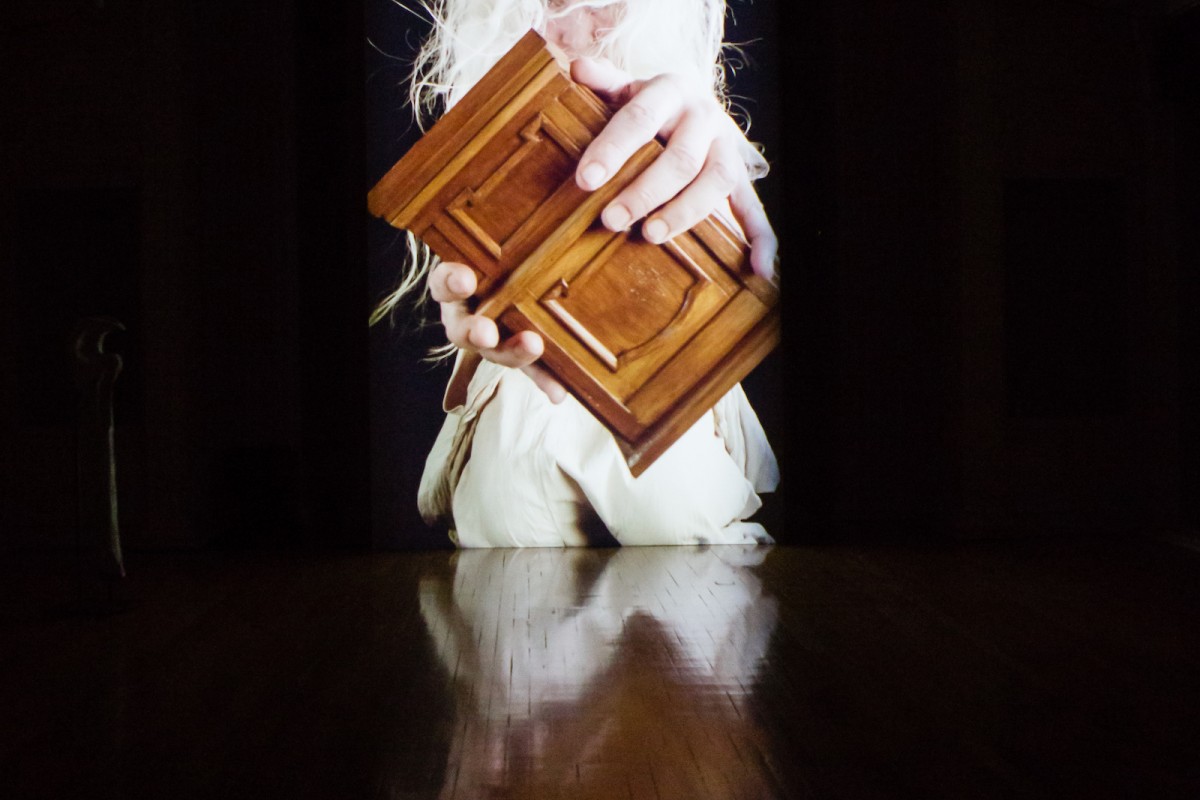Jesse Jones / Tremble Tremble
-

Bewitching audiences from Venice, to Singapore, to Dublin, Tremble Tremble now arrives in Edinburgh, performed daily in Talbot Rice Gallery’s magnificent Georgian Gallery.
Sitting somewhere between sculpture, film and theatre, the artwork evolves each time it is shown, becoming part of its context. The artwork’s new world order is feminist, uncompromising, magical and mythical. Tremble Tremble churns testimony, court statements, song and artefacts into a towering bodily incantation.
Featuring:
Performer and Artistic Collaborator: Olwen Fouéré
Sound Design and Composition: Susan Stenger
Production Manager & AV Programmer: Aaron Kelly Exhibition
Dramaturg: Tessa Giblin
Object Fabrication: Rachel Fallon, James L Hayes and Catriona Gilbert
Performers: Katie Dibb, Tamara Elkins, Fiona Halliday and Connie Hurley
Tremble Tremble was commissioned and curated by Talbot Rice Gallery Director, Tessa Giblin, for Ireland at Venice, an initiative of Culture Ireland in partnership with the Arts Council, for the 57th Venice Biennale in 2017.
Tremble Tremble was originally produced and supported by Project Arts Centre; Principal Sponsor: Dublin Port Company; International Partner: LASALLE College of
the Arts, Singapore; Production Partner: Institute of Art, Design + Technology (IADT); Proudly supported by CIT Crawford College of Art & Design; Talbot Rice Gallery, Edinburgh College of Art and the University of Edinburgh; South Dublin County Council and Rua Red; Dublin City Council; Dublin City Gallery The Hugh Lane; the Irish Museum of Modern Art.
The presentation in Edinburgh has been supported by Creative Scotland, and Culture Ireland as part of GB18: Promoting Irish Arts in Britain.
#trembletremble
#CultureIrelandGB18
Exhibition Guide
Published on the occasion of 'Tremble Tremble' at Talbot Rice Gallery, University of Edinburgh. Edited by Tessa Giblin.
Texts by Tessa Giblin and James Clegg are available to view below, or download free of charge.

Jesse Jones 'Tremble Tremble' 2018
'Tremble Tremble' is an artwork that emerged out of Ireland’s inspiring journey to social change. As an artist, Jesse Jones has long been involved with ideas around class struggle and historical social movements. 'Tremble Tremble' builds on this background, diving deep into the historical oppression of women.
The 30-minute experience of 'Tremble Tremble' is indicative of what Jones calls ‘expanded cinema’, where objects are arranged ‘like runes’. It is rebuilt for the particular rooms in which it is shown: the Arsenale in Venice; a huge white cube in Singapore; a black-box theatre in Dublin; and Talbot Rice Gallery’s magnificent Georgian Gallery in Edinburgh. New elements are added or changed each time. The primary relationship Jones aims to create is between the visitor and the Giantess, a looming figure, which recalls the primal memory of giant eyes peering down at our infant selves. Throughout the work various voices and historical artefacts are brought into focus, building into a cacophony of primal feminism, fuelled by witch-lore, legal documents, artefacts, ancient histories and a fantastical story of ‘legal’ origin.
Installed at the far end of the Georgian Gallery is an Irish declaration from 1821 repealing the Witchcraft Act of 1586. This introduces the historical context of the artwork, which draws upon 'Caliban and the Witch' by Italian theorist and historian Silvia Federici. This book addresses the historical moment when the early accumulation of capital provoked the systematic oppression of women. She writes: ‘There is no doubt that in the transition from feudalism to capitalism women suffered a unique process of social degradation that was fundamental to the accumulation of capital and has remained so ever since.’ If you wanted to control capital in the 12th century, then you needed to control the source of the labour force, women, and their reproductivity. This is the age in which midwifery is taken away from women and adopted by the church and state, and this is the beginning of the oppression of women that will find its height in the hysteria of the witch-hunts, which still haunt us, as is evident in modern Ireland. 'Tremble Tremble'’s title is inspired by the 1970s Italian ‘Wages for Housework’ campaign, during which women chanted, ‘Tremate, tremate, Tremble, tremble, the witches have returned!’
Witches abound within 'Tremble Tremble'. The scene in which the Giantess looms over us begins with testimony from Temperance Lloyd, accused of witchcraft and burned at the stake in the town of Bideford, Devon, in 1682: ‘Did I disturb ye good people? I hopes I disturb ye, I hopes I disturb ye enough to want to see this, your house, in ruins all around ye! Have you had enough yet? Or do you still have time for chaos? Hah? More?’ Olwen Fouéré, the actor who created the towering Giantess, later prowls a terrain, littered with remnants of a courthouse. Her garbled and regurgitated words are recounting text from the Malleus Male carum of 1487, commonly known as the Hammer of Witches. The 'Malleus Male carum' was essentially a guide to identifying, accusing, trying and then destroying women accused of witchcraft, which sold more copies than any other book except the Bible until 1678. It was an incredibly in uential and destructive book.
Created especially for this context in Scotland is a new scold’s bridle, made in collaboration with ECA’s Catriona Gilbert. Intended to muzzle a woman accused of witchcraft, and silence the power of her speech, many scold’s bridles were also decorated or made to reference animal forms, as women were paraded through villages and towns as a public shaming, inducing terror. As Jones states, 'with 'Tremble Tremble' I wanted to make something that wasn’t just a representation of the story of feminism, or the return of witch-power, I wanted to make [an artwork] that incorporated some of the physical and material apparatus of witchcraft... Some aspects of the artwork have been communicated to me through tarot cards or come together through processes of dreaming. It’s deeply connected to my unconscious, as well as my research and political and rational conscious. People feel very confused with [the current] break between truth and language... how do we merge the cerebral and the intellectual with also what we might feel politically?’

Witches abound within 'Tremble Tremble'. The scene in which the Giantess looms over us begins with testimony from Temperance Lloyd, accused of witchcraft and burned at the stake in the town of Bideford, Devon, in 1682: ‘Did I disturb
ye good people? I hopes I disturb ye, I hopes I disturb ye enough to want to see this, your house, in ruins all around
ye! Have you had enough yet? Or do you still have time for chaos? Hah? More?’ Olwen Fouéré, the actor who created
the towering Giantess, later prowls a terrain, littered with remnants of a courthouse. Her garbled and regurgitated words are recounting text from the Malleus Male carum of 1487, commonly known as the Hammer of Witches. The Malleus Male carum was essentially a guide to identifying, accusing, trying and then destroying women accused of witchcraft, which sold more copies than any other book except the Bible until 1678. It was an incredibly influential and destructive book.
Created especially for this context in Scotland is a new scold’s bridle, made in collaboration with ECA’s Catriona Gilbert. Intended to muzzle a woman accused of witchcraft, and silence the power of her speech, many scold’s bridles were also decorated or made to reference animal forms, as women were paraded through villages and towns as a public shaming, inducing terror. As Jones states, 'with 'Tremble Tremble' I wanted to make something that wasn’t just a representation of the story of feminism, or the return of witch-power, I wanted to make [an artwork] that incorporated some of the physical and material apparatus of witchcraft... Some aspects of the artwork have been communicated to me through tarot cards or come together through processes of dreaming. It’s deeply connected to my unconscious, as well as my research and political and rational conscious. People feel very confused with [the current] break between truth and language... how do we merge the cerebral and the intellectual with also what we might feel politically?’

Pursuing a long-term archaeology of a collective unconscious, Jones also connects her mythological giant (born of the Celtic stories of origin) to the 3.5 million-year-old skeletal specimen named Lucy Australopithecus (a hominid species who predates Homo erectus, Homo sapien and Neanderthal), and the oldest known specimen in the world. Jones has based the giant white bones in 'Tremble Tremble' on the bones of Australopithecus, and it is her story that Olwen Fouéré recounts as the camera traverses her body as though a sleeping-giant landscape.
At the core of the artwork is a new proclamation heralding the law of In Utera Gigantae. This law is ‘antecedent and superior’ – made of myths, of the giants, and not the social institution or ‘manmade law’: ‘From the moment a human being takes its place of dwelling in the maternal belly, it lives inside a giant. The state acknowledges and a rms that the life of the giant, in virtue of her status as the origin of all life, shall be protected and vindicated before all other emerging lives she may generate... Be it ordained and enacted that the giant from which life emerges possesses a power to create and to destroy the life she carries... The state accordingly guarantees to pass no law attempting to infringe upon the fundamental rights of In Utera Gigantae.’
Although 'Tremble Tremble' is not straightforward activism, it is very much rooted in the resounding political movement in Ireland that sought to repeal the Eighth Amendment, and in the law of In Utera Gigantae Jones is clearly invoking the mother’s right to bodily self-determination. When Jones was selected to represent Ireland at the Venice Biennale, with Talbot Rice Gallery Director Tessa Giblin as commissioner and curator, the right to same-sex marriage in Ireland had been won through popular referendum a few years before, and since then, momentum had been gathering for yet another attempt to repeal the Eighth Amendment. This amendment to the Irish constitution equated the life of the foetus to the life of the mother in the eyes of the state and the law, making abortion in Ireland illegal and forcing thousands of women to travel the Irish Sea every year, with the trauma su ered in secret and in shame.
Large-scale curtains that contain images of massive, enveloping arms are pulled through the space by performers, a circle is carved into the wall, and plumes of smoke emerge from cracks in William Henry Playfair’s Georgian Gallery floor. Inserting the artwork into this former Natural History Museum and the heart of Edinburgh’s patriarchal history, Jones has fashioned what appears to be a new gaping crack in the ancient oorboards. While the original oorboards have been perfectly maintained, the e ect is that of a shocking intervention: the crack has been carved in the likeness of the chasm over which would wait the Oracle of Delphi – and implies a female seer has been made manifest within the University’s Old College.
To the tune of the work song, with lyrics written by Jesse Jones and music and sound composed throughout the work by Susan Stenger, Jones’ work lifts its foot into the air and stomps down with purpose.
Tremate, Tremate.






